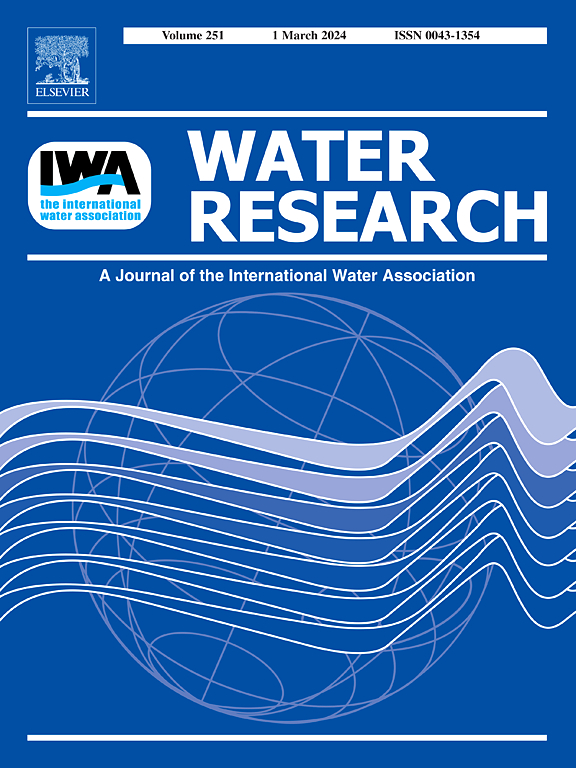Thioarsenate immobilization by ferrous sulfides for geogenic contaminated groundwater rehabilitation: Mechanisms and kinetic constraints
IF 11.4
1区 环境科学与生态学
Q1 ENGINEERING, ENVIRONMENTAL
引用次数: 0
Abstract
Thioarsenic prevails in sulfidic environments and exhibits higher mobility than arsenate (As(V)) and arsenite (As(III)), posing sustaining challenge to the effectiveness of geogenic As-contaminated groundwater rehabilitation. Ferrous sulfide (FeS) minerals are proposed scavengers of monothioarsenate (MTA) in sulfidic groundwater, but the underlying mechanisms and kinetic processes remain elusive. This research presents new key evidence that MTA retention by FeS is constrained by a multi-reaction process: initial rapid adsorption, and subsequently slow binding to kinetics-controlled sites and irreversibly-retained phase. Polysulfides critically strengthen MTA retention by transforming MTA to less mobile As(V) and facilitating arsenopyrite (FeAsS) production. Simulating MTA isothermal adsorption edge with modified dual mode model confirms that MTA removal involves surface chemisorption and mineral transformation. While MTA removal rates were higher under weakly acidic conditions (pH 6-7), more stable FeAsS formed under alkaline conditions (pH 8-9) can strengthen As immobilization against re-desorption. Further column experiments to mimic in-situ FeS coating for MTA immobilization indicate that the simultaneously formed FeS, which induces MTA co-precipitation and production of pyrite and FeAsS, exhibited greater retention capacity than the pre-loaded FeS. These findings manifest important implications in scheming modes of in-situ Fe coating and transformation for managed rehabilitation of As-contaminated groundwater.

硫化铁对地源污染地下水修复的硫代砷酸盐固定化:机制和动力学约束
硫砷普遍存在于硫化物环境中,并表现出比砷酸盐(As(V))和亚砷酸盐(As(III))更高的流动性,对地源性砷污染地下水修复的有效性构成持续挑战。硫化亚铁(FeS)矿物被认为是含硫化物地下水中单硫砷酸盐(MTA)的清除剂,但其潜在的机制和动力学过程尚不清楚。该研究提供了新的关键证据,表明FeS的MTA保留受到多反应过程的限制:最初的快速吸附,随后缓慢结合到动力学控制位点和不可逆保留相。多硫化物通过将MTA转化为流动性较差的As(V)和促进毒砂(FeAsS)的生成,从而加强MTA的保留。用改进的双模模型模拟MTA等温吸附边,证实了MTA的去除包括表面化学吸附和矿物转化。弱酸性条件下(pH 6-7) MTA去除率较高,碱性条件下(pH 8-9)形成的FeAsS更稳定,可以加强As的固定,防止再解吸。进一步模拟原位固载FeS涂层MTA的柱状实验表明,同时形成的FeS诱导MTA共沉淀并生成黄铁矿和feas,比预加载的FeS具有更大的保留能力。这些发现对砷污染地下水的原位铁包覆和转化模式的规划具有重要意义。
本文章由计算机程序翻译,如有差异,请以英文原文为准。
求助全文
约1分钟内获得全文
求助全文
来源期刊

Water Research
环境科学-工程:环境
CiteScore
20.80
自引率
9.40%
发文量
1307
审稿时长
38 days
期刊介绍:
Water Research, along with its open access companion journal Water Research X, serves as a platform for publishing original research papers covering various aspects of the science and technology related to the anthropogenic water cycle, water quality, and its management worldwide. The audience targeted by the journal comprises biologists, chemical engineers, chemists, civil engineers, environmental engineers, limnologists, and microbiologists. The scope of the journal include:
•Treatment processes for water and wastewaters (municipal, agricultural, industrial, and on-site treatment), including resource recovery and residuals management;
•Urban hydrology including sewer systems, stormwater management, and green infrastructure;
•Drinking water treatment and distribution;
•Potable and non-potable water reuse;
•Sanitation, public health, and risk assessment;
•Anaerobic digestion, solid and hazardous waste management, including source characterization and the effects and control of leachates and gaseous emissions;
•Contaminants (chemical, microbial, anthropogenic particles such as nanoparticles or microplastics) and related water quality sensing, monitoring, fate, and assessment;
•Anthropogenic impacts on inland, tidal, coastal and urban waters, focusing on surface and ground waters, and point and non-point sources of pollution;
•Environmental restoration, linked to surface water, groundwater and groundwater remediation;
•Analysis of the interfaces between sediments and water, and between water and atmosphere, focusing specifically on anthropogenic impacts;
•Mathematical modelling, systems analysis, machine learning, and beneficial use of big data related to the anthropogenic water cycle;
•Socio-economic, policy, and regulations studies.
 求助内容:
求助内容: 应助结果提醒方式:
应助结果提醒方式:


